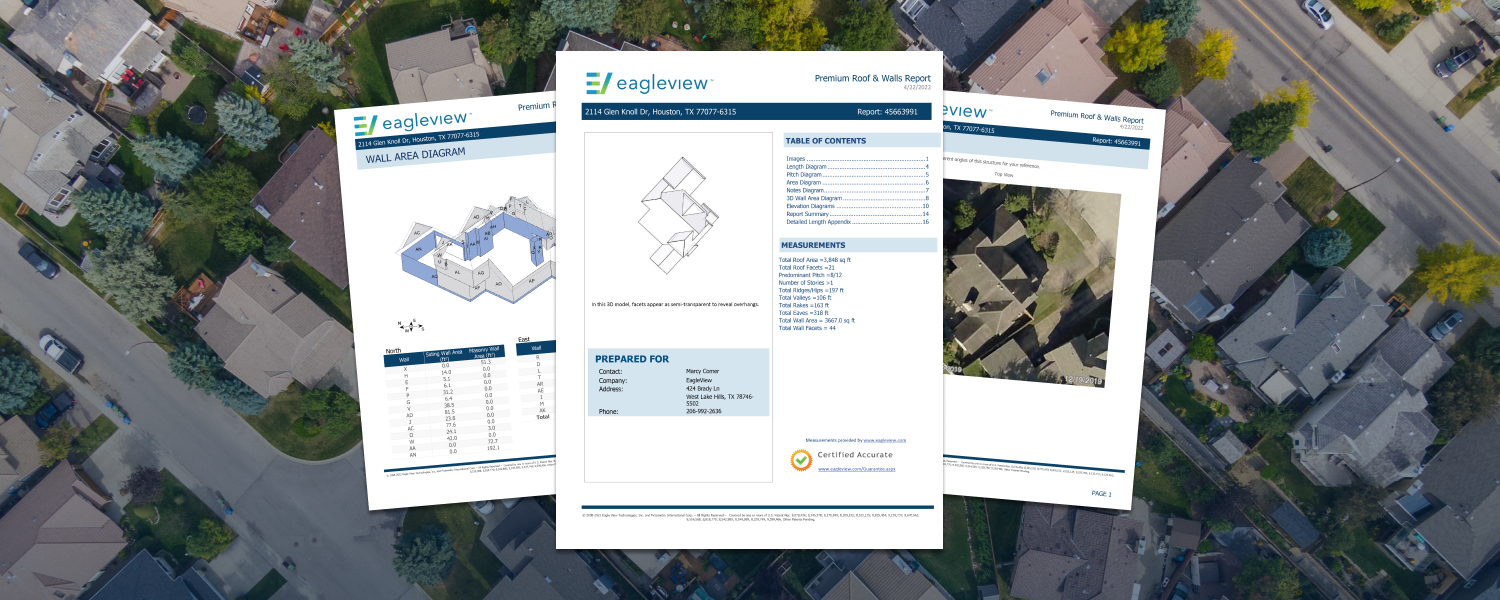7 Reasons Why Claims Adjusters Should Use Residential Roof Reports

Managing a property and casualty claims department is complex and expensive. Processing claims requires adjusters and keeping policyholders informed and satisfied can be challenging.
Claims payouts are also a carrier’s largest expenses. Paid losses, investigative costs and settlement expenses accounted for about 70% of premiums collected in the United States in 2020. To maximize efficiency, and manage costs, claims departments want access to the best information, quickly. When roof damage leads to a property claim, an adjuster needs roof measurements and diagrams. A residential roof report is an easy way to collect this information.
What is a Residential Roof Report for Insurance?
A roof report is a collection of roof measurements, diagrams and photographs for a specific property.
The measurements help an adjuster learn about the size of a roof before visiting a property to inspect damage. Important measurements include roof length, area, and pitch, as well as hips, ridges, valleys, rakes, eaves, drip edges, flashing, step flashing and parapet walls. The roof diagrams, including a 3D model, outline the shape and steepness of the roof. Aerial photographs provide visual context and show what a roof looked like before a claim was filed.
Packed with measurements and other valuable information, a roof report helps an adjuster calculate accurate replacement or repair costs.
Obtaining a roof report is easy. An adjuster can order a report through claims management software or a roof report provider.
Why Adjusters Should Use Residential Roof Reports: The 7 Reasons
1. Have Roof Measurements in Hand Before Going Onsite
After receiving a first notice of loss, an adjuster needs roof information, and a roof report is an easy way to obtain measurements and diagrams. That leaves damage assessment as the primary task when visiting a property. Using a roof report shortens the claims cycle time.
Instead of using roof reports, some carriers ask adjusters to take measurements or upload pictures while visiting a property. Those methods create more work for adjusters and slow down the claims process.
2. Collect Accurate Roof Measurements
The measurements in a roof report are extracted from high-resolution aerial photographs using innovative technologies. These measurements are extremely precise and widely used by insurance carriers, roofers and contractors. Adjusters can have confidence in the measurements.
Relying on adjusters to take roof measurements comes with risk. Measurement mistakes and discrepancies can lead to supplemental claims, which extend the claims process and increase loss adjustment expenses.
3. Create Fair Claims Settlements
Roof measurements help adjusters calculate the materials needed to replace or repair a roof. While replacement and repair costs depend on a roof’s size, coverings and other factors, a full replacement costs about $11,500 for an average-sized home. An adjuster can use the measurements in a roof report to make precise cost calculations.
Insurers gain two benefits by calculating replacement costs accurately. The first benefit is less leakage. The second benefit is increased policyholder satisfaction.
4. Order Reports and Build 3D Wireframes Within Claims Management Software
Estimating software such as Xactimate (Verisk) and CoreLogic integrate roof reports. Within the software, an adjuster can access roof measurements and create a 3D wireframe of the roof. A digital version of a roof is important for producing a full, and accurate, claims estimate.
5. Gain Measurements for Many Properties at the Same Time
Another advantage of roof reports is bulk ordering. Reports can be ordered for all damaged homes after a severe weather event. This is the fastest way to secure measurements and diagrams for many properties.
Carriers who do not use reports may be relying on onsite visits to collect roof photos or measurements. This presents a major challenge after a weather event. Road, tree or infrastructure damage can make visiting damaged properties difficult.
6. Improve Employee Safety
Roof reports offer another simple benefit – employee safety. Managing a ladder is difficult and bad weather can make a slip-and-fall more likely. To illustrate the risks of working on roofs, the Occupational Safety and Health Administration (OSHA) offers educational materials and recommendations to help employers keep employees safe.
Simply put, climbing onto a damaged roof to take measurements is dangerous. The risks can be avoided by using a residential roof report.
7. Adopt An Industry Best Practice
Many insurance carriers are enjoying the benefits of roof reports. These insurers are improving measurement accuracy, reducing supplemental claims and lessening claims leakage.
Why Use Residential Roof Reports
A roof report is a simple tool that shortens claims cycle times. A report’s measurements, diagrams and 3D models make it easier to process a claim and calculate replacement and repair costs.
To learn how insurance carriers benefit from EagleView’s roof reports, fill out our form to request a call.
In addition to roof reports, EagleView offers Walls, Windows & Doors reports and Full House ™ reports, which include both roof measurements and walls, windows and doors measurements.
